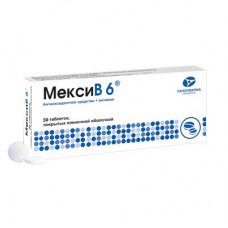Expiration date: 05/2026
Dosage form: tablet, film coated
Composition: 1 tablet, film-coated, contains:
active substance: Ethylmethylhydroxypiridine succinate 125 mg, pyridoxine hydrochloride 10 mg;
excipients: calcium hydrogen phosphate dihydrate, copovidone (kollidon
VA–64 or Plasdone es–630), silicon dioxide colloidal (Aerosil), croscarmellose sodium (Primerose), magnesium lactate, magnesium stearate, castor oil of hydrogenase-based, cellulose microcrystalline;
the composition of the film shell: Selichot AQ–02003 [hypromellose (hydroxypropylmethyl-cellulose), macrogol (polyethylene glycol 6000), titanium dioxide].
Description
Round, biconvex tablets, film-coated white or almost white. In cross section, almost white.
Pharmacotherapeutic group: antioxidant + vitamin.
Pharmacological properties
MexiB 6® is a combined preparation.
Pharmacodynamics
Ethylmethylhydroxypiridine succinate is an inhibitor of free radical processes — membraneprotective, possesses also antihypoxic, substance revealing a stress protective, nootropic, antiepileptic and anxiolytic action. Antioxidant drug that regulates metabolic processes in the myocardium and vascular wall.
The mechanism of action is due to antioxidant and membrane-protective properties. Inhibits lipid peroxidation, increases the activity of superoxidised, increases the ratio of lipid-protein that improves the structure and function of cell membranes. Modulates the activity of membrane-bound enzymes, receptor complexes, which promotes the preservation of structural and functional organization of biological membranes, transport of neurotransmitters and improve synaptic transmission. Increases concentration in the brain of dopamine.
Enhances compensatory activation of aerobic glycolysis and reduces the degree of inhibition of oxidative processes in the Krebs cycle in hypoxia with an increase in adenozintrifosfornoy acid (ATP) and creatine phosphate activates energosintezirutuyu mitochondrial function.
Increases organism resistance to influence of various damaging factors in pathological conditions (shock, hypoxia and ischemia, cerebrovascular accident, ethanol intoxication and antipsychotic drugs).
Improves metabolism and blood flow in brain microcirculation and blood rheology, reduces platelet aggregation. It stabilizes the membranes of red blood cells (erythrocytes and platelets), reducing the likelihood of hemolysis. Has hypolipidemic effect, reduces total cholesterol and low-density lipoprotein (LDL).
Improves the functional state of the ischemic myocardium, reducing the manifestations of systolic and diastolic dysfunction of the left ventricle (LV) and electrical instability of the myocardium.
In terms of critical reduction of coronary blood flow promotes the preservation of structural and functional organization of membranes cardiomyocytes stimulates the activity of membrane enzymes — phosphodiesterase, adenylate cyclase, acetylcholinesterase. Supports evolving in acute ischemia the activation of aerobic glycolysis and contributes to hypoxic conditions in the restoration of mitochondrial redox processes and increases the synthesis adenozintrifosfornoy acid (ATP), creatine phosphate and other makroergov. Increases collateral blood flow to ischemic myocardium and activates energosintezirutuyu processes in the area of ischemia, which contributes to the preservation of the integrity of cardiomyocytes and maintain their functional activity.
In patients with stable angina improves exercise tolerance and antianginal activity of nitrates, improves the rheological properties of blood, reduces the incidence of acute coronary insufficiency.
Pyridoxine, entering the body, fosfauriliruetsa, is converted into pyridoxal–5-phosphate and is part of enzymes, carrying out the decarboxylation, transamination and racemization amino acids, and enzymatic transformation of sulfur-containing and hydroxylated amino acids. Involved in metabolism; necessary for normal functioning of the Central and peripheral nervous system. Pyridoxine involved in the metabolism of tryptophan, methionine, cysteine, glutamic and other amino acids. Plays an important role in the metabolism of histamine. Promotes normalization of lipid metabolism.
Pharmacokinetics
Ethylmethylhydroxypiridine succinate is rapidly absorbed when administered orally (period of poluabsorbtion — 0,08–1 hour). The time to maximum concentration (Tcmax) ingestion — 0,46–0,5 h. the Maximum concentration (Cmax) when administered by 50-100 ng/ml. Rapidly distributed to organs and tissues. The average time of retention of Ethylmethylhydroxypiridine of succinate in the organism by ingestion — 4,9–5,2 h
Ethylmethylhydroxypiridine succinate is metabolized in the liver by glukuronirovania. Identified 5 metabolites: 3-hydroxypyridine phosphate is formed in the liver and involvement of alkaline phosphatase breaks down into phosphoric acid and 3-hydroxypyridine; 2-th metabolite is pharmacologically active, it is formed in large quantities and is found in the urine for 1-2 days after administration; the 3rd is excreted in large quantities in the urine; 4th and 5th — glucuroconjugated. The half-life when administered by a 4.7–5 PM Rapidly excreted in the urine mainly as metabolites (50% in 12 h) and in small quantities — unchanged (0.3% in 12 h). The most intensively excreted during the first 4 h after administration of etilmetilgidroksipiridina succinate. Figures out with the urine unchanged etilmetilgidroksipiridina succinate and metabolites have a significant individual variability.
Pyridoxine is rapidly absorbed throughout the small intestine, a greater number absorbed in thin intestine. Metabolized in the liver with the formation of pharmacologically active metabolites (pyridoxal phosphate and pyridoxamine). Pyridoxal phosphate binds to plasma proteins by 90%. Well penetrates into all tissue; accumulates mainly in the liver, less — in muscles and the Central nervous system (CNS). Penetrates through the placenta, secretiruetsa in breast milk. The elimination half-life (T1/2) — 15-20 days. Excreted by the kidneys (when administered intravenously — the bile 2%), and during hemodialysis.
Indications for use
In combination therapy:
dyscirculatory encephalopathy;
syndrome vegetative dystonia;
anxiety disorders with neurotic and neurosis-like States;
withdrawal syndrome in alcoholism with the prevalence of neurosis and vegetative-vascular disorders;
coronary heart disease (prevention of attacks);
conditions after acute intoxication antipsychotic means;
asthenic conditions, as well as for prevention of development of somatic diseases under the influence of extreme factors and loads;
exposure to extreme (stress) factors.
Contraindications
Hypersensitivity; severe hepatic and/or renal failure;
pregnancy, lactation, children's age.
Caution: peptic Ulcer and 12 duodenal ulcer.
Method of application and doses
Inside, on 1 tablet 3 times a day; initial dose of 1-2 tablets 1-2 times per day with a gradual increase to produce a therapeutic effect. The maximum daily dose of 6 tablets/day. The duration of treatment is 2-8 weeks. If necessary, possibly re courses.
Side effects
Nausea, dry mouth, diarrhea, drowsiness, allergic reactions, hypersecretion of hydrochloric acid (HCl), numbness, a sense of compression in the limbs — a symptom of "stocking" and "gloves", the decline of lactation (sometimes used as a therapeutic effect).
Overdose
Symptoms: sleep disorders (insomnia, in some cases, drowsiness).
Treatment usually is not required — the symptoms disappear on their own within a day. In severe cases when insomnia, nitrazepam 10 mg, oxazepam 10 mg or diazepam 5 mg.
Interaction with other drugs
Enhances the action of benzodiazepine anxiolytics, antiepileptic (carbamazepine),
antiparkinsonian drugs (levodopa), nitrate
Reduces the toxic effects of ethanol.
Enhances the action of diuretics; combines well with cardiac glycosides (pyridoxine promotes the synthesis of contractile proteins in the myocardium), with glutamic acid, and potassium and magnesium asparaginata (increased resistance to hypoxia). Pyridoxine farmatsevticeski incompatible with thiamine and cyanocobalamin. Isoniazid, penicillamine, cycloserine and estrogensoderjaschie oral contraceptives weaken the effect of pyridoxine.
Special instructions
During the period of treatment must be careful when driving and occupation of other potentially hazardous activities, require high concentration and psychomotor speed reactions.


